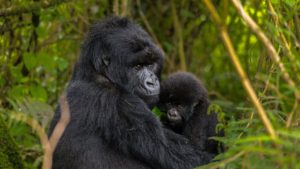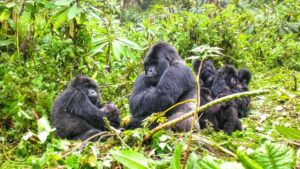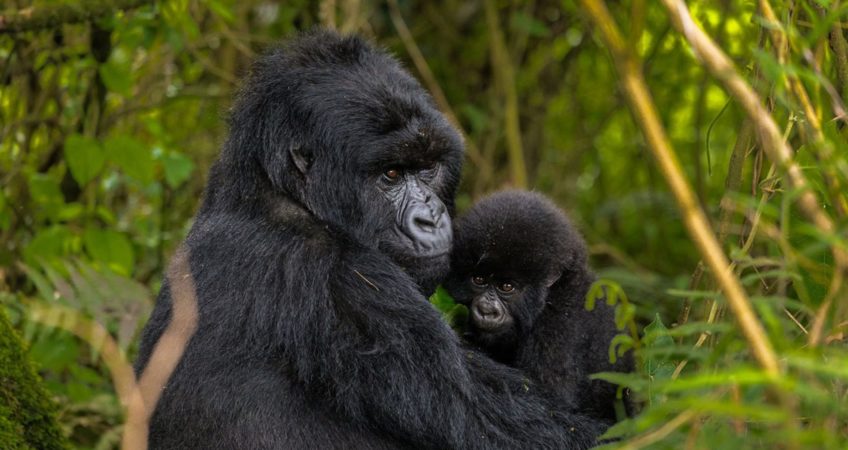Gorillas are ranked the largest primate apes native to Africa compared to other great apes such as chimpanzees, bonobos, orangutans, gibbons and humans. Mountain Gorillas are found in only three East African countries which are Uganda, Rwanda and Congo. In Uganda they are found in the greenery of Bwindi impenetrable national park, Mgahinga national park and Virunga mountains. Gorillas are basically divided into two groups the mountain gorillas and low land gorilla.

Mountain gorillas derive their name from living into the mountainous regions of central Africa hence the name while the lowland gorillas lives in dense forests of central and western Africa. It’s believed that two groups are quite similar with a few differences depending on the hair. Mountain gorilla comprises of longer hair while lowlands have soft and short hair according to Smithsonian. Mountain gorillas are 4 to 6 feet tall and weigh 300 to 485 lbs. equivalent to 135 to 220kg. These endangered species are commonly known to possess over 98.8% of the human DNA. The only difference is they walk on four and this terrestrial locomotion is referred to as knuckle walking. Below are the facts about mountain gorillas
1. Feeding
Mountain Gorillas are herbivorous animals which do not consume any fresh but feed on foliage such as wild celery like shoots, roots, tree barks, tree pulp and fruits. These primate species sometimes feed on snails, barks and ants for a daily living. They are believed to consume 40 lbs. which is 18kgs a day and rest during midday. . Since they spend their entire life in the forest, it’s easier for them to collect the gorilla  diet for easy survival in the jungle. It’s believed that gorillas hardly take water but the little water is obtained from the fresh vegetables.
diet for easy survival in the jungle. It’s believed that gorillas hardly take water but the little water is obtained from the fresh vegetables.
2. Habitat
Mountain Gorillas inhabit in flat greeneries and mountainous areas and in Uganda are basically found in Bwindi impenetrable national park, Mgahinga national park and Virunga mountains spanning between Rwanda and Congo. These primate species live their life time mostly in the rain forests and construct nests for resting during midday.
3. Reproduction
Man’s closest cousin the gorillas reproduce internally and give birth to one youngster. . It’s very difficult to tell that a gorilla is pregnant because of its round stomach even after feeding. Gorillas get pregnant at the age of 10 years. They have the same gestation period of nearly 9 months like a human being. The infant weighs 3- 4 pounds and mother gorilla looks after its infant from 4-6 year while carrying it on her back as a way of transportation. At the age of 8-10 years the gorilla is no longer in the infant stage but looked at as an adult. The gorillas live for over 35 years in the forest and over 50 years in the zoo.
4. Social behaviors
These primate species live in groups of over 50 members. These groups are led by a dominant silver back and this is identified according to its grey hair on its back. It’s the duty of the silver back to protect and direct the troop to the next direction. A silver back is  stronger than 12 male human beings. The mother gorilla looks after new born as they work hand in hand with the silver back to play, teach and protect the infants from encountering any danger and falling into snares trapped for other animals. After eating, they rest during midday so as to plan for the next move and they construct new shelter depending to where the night has found them.
stronger than 12 male human beings. The mother gorilla looks after new born as they work hand in hand with the silver back to play, teach and protect the infants from encountering any danger and falling into snares trapped for other animals. After eating, they rest during midday so as to plan for the next move and they construct new shelter depending to where the night has found them.
5. Communication
The largest ape has over 22 vocalization and they can communicate in various ways which include postures, gesture and facial expression. These generous creatures communicate in different feelings such as the playful chuckling when happy, welcoming and cheering. Gorillas are affectionate whereby they mimic the visitors’ ways for example Koko the famous female gorilla known internationally for learning the common sigh language and over 2000 English words. They make loud grunt roars beating hard their chests when they get angry and about to charge.
6. Structure
They possess over 98.3% of human DNA in that they do similar things like that of a human being. They have hands with big webbed thumbs and can stand on their two legs and sometimes walk upright. In the

process of running they use both the hands and the hind legs. Gorillas live in a troop of over 30 members led by the silver back a male gorilla. It’s the role of the silver back to lead and also protect the troop. A troop has to have one silver back and the rest of the members are all females with their young ones. The female Gorillas fight till their last breath to protect their young ones, they also make vine nests where the little ones rest.
7. Emotional
Gorillas are full of emotions when they interact with people. The young ones are friendly and when tickled they laugh and if hurt they cry and show misery. They get excited when they see people and make different sounds to express their joy while others pose when photos are taken. Gorillas are gentile and calm. Some refer to gorillas as terrestrial and others violent according to movies watched such as the Rise of the planet of apes. There calmness is seen when they don’t compete for territories. Most of their time is spent gathering food across large areas.
8. Gorilla threats
Gorillas suffer threats from Humans. The humans are a great threat to gorillas as they keep hunting them down for illegal trade and meat. They also encroach on the park land for human settlement and industrial activities.

It’s interesting to interact with gorillas in their natural setting.You can track this primate species as many times as you want depending on the tracking destination be it Bwindi impenetrable forest or the forests of Mgahinga national park in Uganda and other sister countries. Twice done, best the experience and fun it gets. Book a gorilla safari to meet the endangered ranked giants in the East African countries such as Uganda, Rwanda and Democratic Republic of Congo.
Eyalama adventures Ltd is eagerly more than welcome to take you through the tropical rain forest of the Impenetrable Bwindi and other gorilla destinations for gorilla tracking in Uganda.

